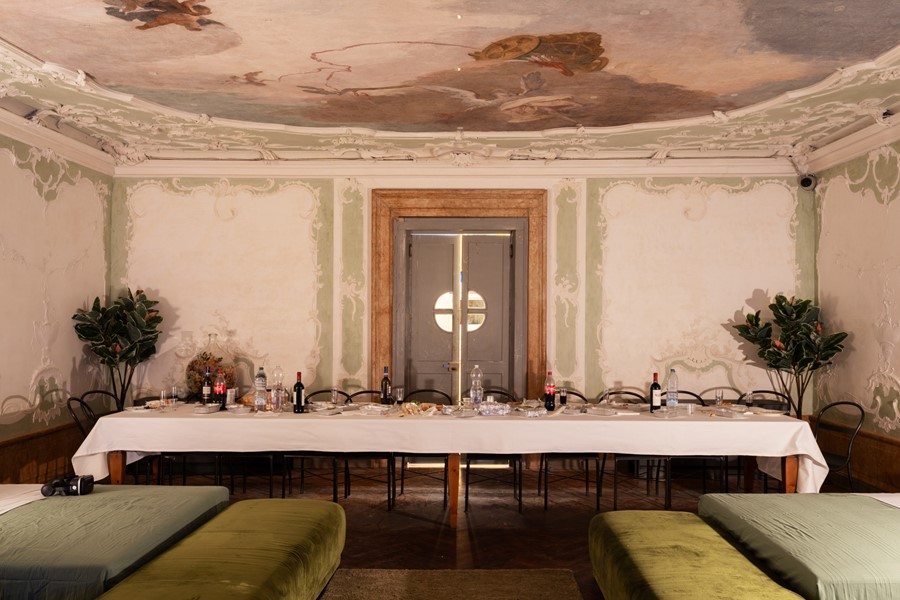From John Akomfrah’s hypnotic British Pavilion to an exhibition by Christoph Büchel at the Fondazione Prada, here are four shows not to miss at the 60th edition of the Venice Biennale
The International Art Exhibition at the Venice Biennale is always epic, and this year, the preview week reliably has the steroidal frenzy of a farce. With a main show curated by Adriano Pedrosa, artistic director of the São Paulo Museum of Art, and featuring 331 artists and collectives, 88 national pavilions representing countries from around the globe, and 30 collateral events spread out across the slowly sinking, labyrinthine city with its candy cane-striped moorings – it’s chaos.
An exercise in seeing it all is futile and thwarts the purpose of going: to actually experience and revel in art that makes your heart beat in one of the most beautiful cities in the world. The main site alone, the Arsenale (a former rope factory on the southern edge of the city), at nearly 115,000 metres squared, is impossible to take in all at once. Yet, the need to scan and pan for art gold is fairly common: many journalists and curators I encounter have only ‘quickly darted around’ X or ‘took a glimpse’ at Y, leaving without much of a feeling for shows others were raving about. It’s hard to know where to lavish your time when there’s so much to see.
This year’s title, Stranieri Ovunque – Foreigners Everywhere – offered toothsome themes. The phrase comes from the name of a Turin collective that fought racism and xenophobia in Italy in the early 2000s – and it’s especially pertinent here, just two months after the inauguration of the biennale’s new president, the Italian right-wing journalist and public intellectual Pietrangelo Buttafuoco. Under this theme, the main show focuses on “artists who are foreigners, immigrants, expatriates, diasporans, exiles or refugees, particularly those who move between the Global South and Global North,” as well as queer and Indigenous artists – anyone whose idea of their place in the world has been threatened.
The resulting main show is thus the most global it has ever been, featuring swathes of artists who’d never been seen in the biennale before, and more than 50 per cent of those featured were dead – it was a large-scale rewriting of the canon. I‘d have preferred the biennale to tell me about the future of global art, or at least what it looks like at this very moment (there was a considerable concentration on textile, folklore and craft from earlier centuries, which at times felt a little clichéd) – but perhaps that’s not possible without this show, without looking at history anew within these exact rooms. Standout shows wove together these themes with vast complexity and evocative world-building, trying to envision new futures in the wake of a very complicated past.
For anyone attending the biennale once the madding crowds have ebbed (though there will always be troupes of fluoro poncho-wearing tourists blocking the bridge), here are four exhibits one could spend days in.
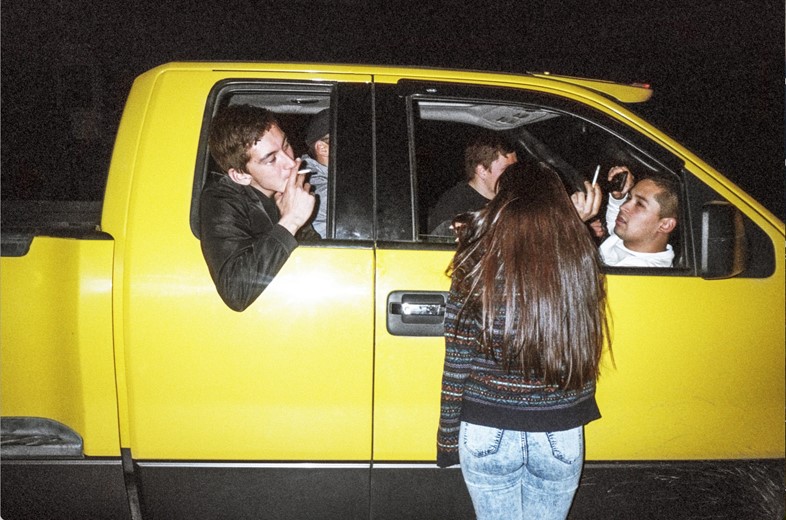
Danish Pavilion – Rise of the Sunken Sun by Inuuteq Storch
This one in the Giardini is easy to miss since its signage, usually reading ‘Danmark’, has been struck through and overwritten with the words ‘Kalaallit Nunaat’ – Greenlandish for ‘Greenland’. Referring to the Danish colonial rule of Kalaalit Nunaat from the early 18th century until 1979, Kalaalit photographer Intuuq Storch upends the notion of nation in a raw and intimate portrait of his starkly beautiful, underrepresented homeland.
Rise of the Sunken Sun is expansive and absorbing on micro and macro scales. Small works of inhospitable snowscapes and domestic interiors are printed onto acetate and cast their silvery shadows onto the wall behind. Next, coloured photographs of Qaanaaq, a northernmost town to which hunting families were displaced in the 1950s, cover the wall: hunting families out on the ice, at home at their kitchen tables surrounded by their daily clutter, teenagers hanging out. The high contrast, grainy film quality in both series heightens the all-encompassing blaze of the snow and the sun, both of which govern life here on a daily basis.
One could spend hours in the final room, where a new Kalaalit Nunaat photographic archive is in the making: on screens, domestic scenes captured by Storch’s grandparents are shown alongside late 19th century photographs by John Møller, the first Kalaalit photographer who turned his lens on the Danes – the strangers. Storch mirrors these composed portraits of soldiers, families and pets, with his own, intimate, close-ups of his friends and family, smoking, driving and goofing about – tiny intimate details emerge with each look.
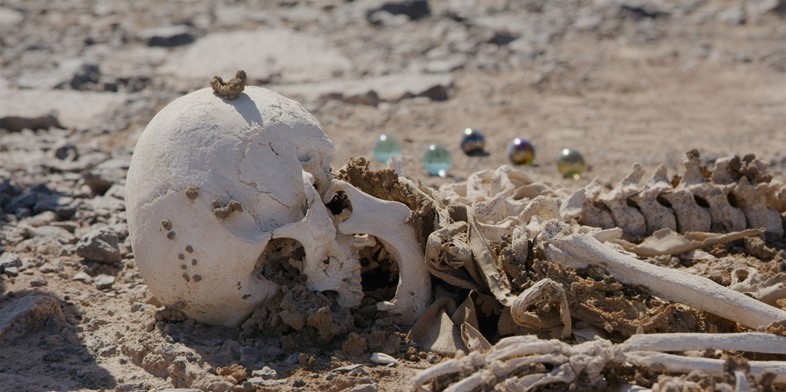
Pinault Collection – Liminal by Pierre Huyghe
Stepping into the pitch-dark setting for Liminal, Pierre Huyghe’s transformation of the Pinault Collection’s Punta della Dogana is like setting foot on another planet. Fellow guests can be seen arms outstretched, feeling for walls, or wielding phone screens lit as torches. The effect is immediately unsettling and estranging, not least thanks to a huge screen with a naked body, breasts exposed, and masked face moving slowly in the gloomy grey light. This is Liminal (2024), a work of art with infinite parameters: the ‘inhuman entity’ moves and gestures according to data and stimuli garnered by environmental sensors in the room and outside.
AI determines the evolution of various other works within the show. For Idiom (2024), mute humans wearing orb-like gold metal masks walk through the venue at intervals. Carrying sensors, the masks collect information from the environment that is converted into a language structure and then vocalised through the mask as if by a bodiless entity – it is as unsettling as you might imagine. In Camata (2024), a self-editing video shows a mystifying funereal ritual performed by a set of machines on the skeleton of a young man in a posthuman Atacama desert, the video evolving continuously. In an aquarium tank, blind and seeing fish living on alternate circadian rhythms share a tank, where the glass switches between opaque and transparent according to more environmental triggers. Weaving between these alien and infinite worlds, the visitor is embedded in an ecosystem and imprints on it – one could revisit a thousand times and the show will always be alien.
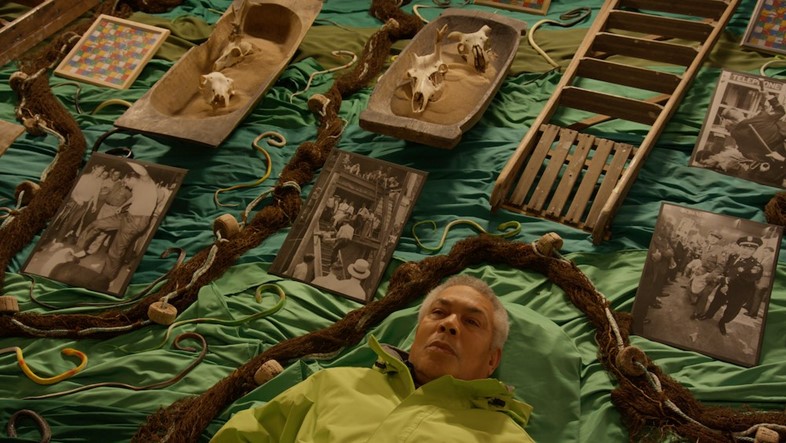
British Pavilion – Listening All Night to the Rain by John Akomfrah
Decades of extensive research went into this multimedia show unravelling stories of post-colonialism and diasporas in Britain – and it’s palpable. Across eight rooms and songs or ‘cantos’, each with its own soundscape and a colour field inspired by painter Mark Rothko, varying migrant narratives are told on multiple screens. Memories from the Windrush generation, of police brutality in the UK, the Mau Mau uprisings in Kenya, the Korean war, struggles for independence in Congo and Nigeria, the Indian Partition – each a legacy of colonial powers. The climate crisis, another legacy of those powers, looms largest as water washes through every screen and countless metronomes and clocks tick hypnotically.
The notion of water as a reservoir for memory (recalling the work of French immunologist Jacques Benveniste) dominates the set piece films, where Akomfrah’s characters, sink in their own memories against a backdrop of wet Yorkshire and Scottish Highland landscapes littered with furniture and domestic detritus – dolls, mirrors, cassette players. Water seems poised to consume them all. They are juxtaposed and cut with found film footage: trucks administering insecticide, 70s global warming warnings, dead soldiers, protests, war, newsreels, violence and more death. The scale of horror is aptly and successfully engulfing. It’s hard to pull oneself away – when you do, you’ll emerge blinking into the daylight, a little ravaged.
Read AnOther’s interview with John Akomfrah here.
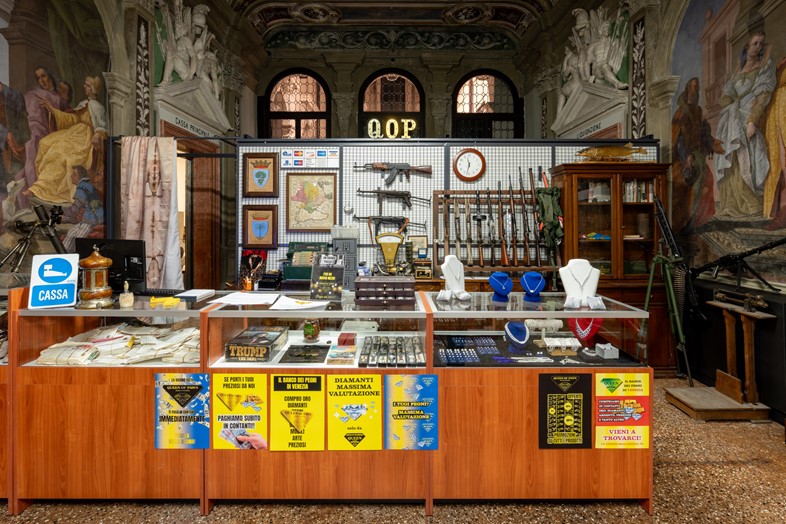
Fondazione Prada – Monte di Pietà by Christoph Büchel
The Fondazione Prada’s Ca’ Corner della Regina site in Venice is almost unrecognisable in the hands of this year’s commissioned artist, Christoph Büchel – it’s another alien land. The palazzo has had many purposes over the years, but under Pope Pius VII’s ownership, it hosted Venice’s Monte di Pietà (Mount of Piety) from 1834 to 1969 (a charity designed to give the poor access to loans at reasonable interest rates thanks to funds from charitable donors, using the borrowers’ belongings as collateral Monte di Pietà sites would over time resemble a bank-cum-thriftshop).
This uncomfortable system lays the foundations for Büchel’s presentation, which explores the role of debt in society and its power structures. Büchel has filled the palazzo with objects – junk barely distinguishable from unlabelled, priceless art by Tiziano, Beuys, Warhol, and Duchamp. On the lower floors are bunkers full of hoarded belongings and hideouts, the stately courtyard is strung with lines of laundry, and counterfeit handbags are laid out on a cheap fleece blanket, ready to be whipped out of sight. On the mezzanine is a deep dive into intangible capital and debt: a rainbow of crypto-mining rigs glow in the corner of a gamer’s pad, a gran-fluencer’s wardrobe leads onto a casino and a strip club, each set-designed to immaculate dishevelment. On the first floor a pawnshop: stacks of speakers, bikes and lamps, rails of clothes including Kappa ‘Venezia’ merch. In adjacent chambers are piles of old fishing paraphernalia, (literal) tonnes of bagged clothing and desks piled high with research, exploring various historical themes pertinent to the show’s ideas – each room defies belief, and brims with thought-provoking detail, riches impossible to exhaust.
Other must-sees at this year’s biennale: Precious Okoyomon’s installation PRE-SKY/EMIT LIGHT: YES LIKE THAT', and Yinka Shonibare’s spectacular clay sculpture Monument to the Restitution of the Mind and Soul at the Nigeria pavilion, Tesfaye Urgessa’s richly figurative paintings curated by Lemn Sissay at the first Ethiopia pavilion; Archie Moore’s sprawling genealogy maps in kith and kin, for the Australia pavilion, Wael Shawky’s opera at the Egypt pavilion, Iva Lulashi’s desaturated, porn-inspired paintings exploring lust as a bodily need at the Albania pavilion in the Arsenale; Josèfa Ntjam’s ‘swell of spæc(i)es’ with LAS Art Foundation. And in the main show: Bouchra Khalili’s large-scale film installation The Mapping Journey Project charting eight exhaustingly zig-zaggy migrant journeys from Africa to Europe; Charmaine Poh’s truly tender films about queer families in Singapore (Kin, 2021; What’s softest in the world rushes and runs over whats hardest in the world, 2024), Karimah Ashadu’s film about the moto-taxi riders of Lagos (Machine Boys, 2024) and Pablo Delano’s absorbing and encyclopaedic The Museum of the Old Colony, 2024.
The 60th Venice Biennale is on show until 24 November 2024.
